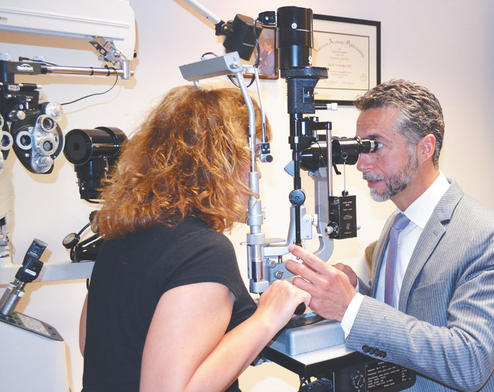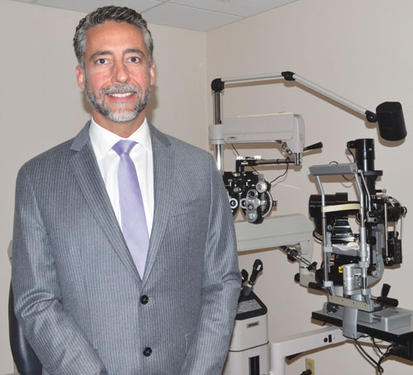The incidence of age-related macular degeneration, a leading cause of blindness among seniors, is expected to double by 2050 as the Baby Boomer generation ages, according to the American Academy of Ophthalmology. The disease, which damages the light-sensitive tissue at the back of the eye called the retina, currently affects about 2.1 million Americans. While the disease is not curable, it is possible to slow down its progression with early detection and treatment.
Dr. Rahul Khurana, an ophthalmologist and retinal specialist, said that there are approximately two million people afflicted with macular degeneration in the United States. Prior to about a decade ago, there were few options to treat the disease. Now, he noted, there are a number of ways to slow its progression. Khurana serves as an associate clinical professor of ophthalmology at the University of California, San Francisco School of Medicine and also practices at the six-office, Mountain View-based Northern California Retina Vitreous Associates.

Dr. Carlos Martinez, managing partner of Eye Physicians of Long Beach, performs an eye exam on a patient. He recommends that patients over the age of 65 schedule annual exams to check for age-related macular degeneration, the most common cause of blindness in seniors. (Photograph by the Business Journal’s Pat Flynn)
Macular degeneration is a disease of the eye that causes damage to the retina, an eye tissue that processes images and relays visual information to the brain. The macula is an oval-shaped, yellow-orange area near the center of the retina responsible for the eye’s sharpest vision.
There are two types of the disease. “The first one is the dry macular degeneration, which is a slowly progressive form and is characterized by buildup of material called drusen underneath the retina,” Dr. Carlos Martinez, managing partner of Eye Physicians of Long Beach, said. “When the drusen become significant enough that it starts to interfere with the metabolism of the photo receptors, then you get visual loss.”
Dr. Dieter Hertzog, a fourth-generation ophthalmologist practicing at Hertzog Eye Care in Long Beach, explained that as drusen deposits enlarge and grow more numerous, people start to notice vision loss in low light conditions. “Then, during the day the central vision starts to drop off, too,” he said. If the disease is allowed to progress untreated, large swaths of central vision may be lost, he noted. Other symptoms include difficulty seeing at night and distinguishing colors, according to Martinez.
“The really bad one is really wet macular degeneration,” Hertzog said. “The wet type is where people develop leaks or bleeds in their retina. There are blood vessels that grow up from a layer called the choroid, which is under the retina, into the tissue and [then] leak or bleed.” Wet macular degeneration can cause rapid vision loss, he said.
“With wet macular degeneration, you can get the onset of scotomas, which are blind spots,” Martinez said. “Or you can get the deformation of images, called metamorphopsia, which basically means that when you look at a straight line, instead of looking straight it starts to look wavy.”
Macular degeneration is the most common cause of visual loss in patients older than 65, Martinez said. He recommended that patients 65 and older have yearly dilated eye exams to check for the disease.
“If one eye starts to lose vision, you often don’t notice it because the other eye kind of compensates,” Khurana said. “And that’s why it’s really important to get your eyes checked. You may be having signs or symptoms, and you may not even realize it because your other eye is doing well.”
There are three injectable medications that are used to treat wet macular degeneration, according to Hertzog. “They reduce production of a molecule called vascular endothelial growth factor,” he said. “And, basically, the gist of what they do is they prevent those blood vessel networks that have proliferated out of control from leaking and bleeding.” Using these drugs, it is possible to maintain a person’s vision and prevent blindness.

Dr. Carlos Martinez, an ophthalmologist and a fellow with several state and national eye physician organizations, explained that while age-related macular degeneration can cause visual loss, it is possible to slow the progression of the disease with treatment. Early detection is key. (Photograph sby the Business Journal’s Pat Flynn)
For dry macular degeneration, the only reliable treatment is a type of multi-vitamin called AREDS-2, Hertzog said. “It doesn’t help prevent development of the disease, but it does help prevent progression,” he explained.
While macular degeneration is often age-related, there are other risk factors. Caucasians are at greater risk of developing the disease, Hertzog noted. “I think the genetic component is the biggest risk factor. So, if you have a family member with it, that’s when you should probably be screened earliest,” he said.
Smoking is another major risk factor. “In fact, if you smoke, you’re twice as likely to develop macular degeneration compared to someone who does not smoke,” Khurana said. High-blood pressure, far-sightedness and obesity are also tied to the disease, according to Martinez.
“A diet rich in anti-oxidants like green, leafy vegetables, fish, and yellow or orange fruit is very important for keeping the macula healthy,” Martinez said. Avoiding sun exposure and smoking are other keys to keeping your eyes healthy, he noted.
All three doctors said they see patients with the condition on a daily basis. “I probably see about 50 or 60 patients every day, and probably 10 of them will have macular degeneration of different severity levels,” Hertzog said.
“Vision-threatening conditions like macular degeneration can now be treated,” Khurana said. “Early detection is imperative to avoid any irreversible damage. I think hopefully if we can get that message out, that would be a really important thing to show to the public.”
